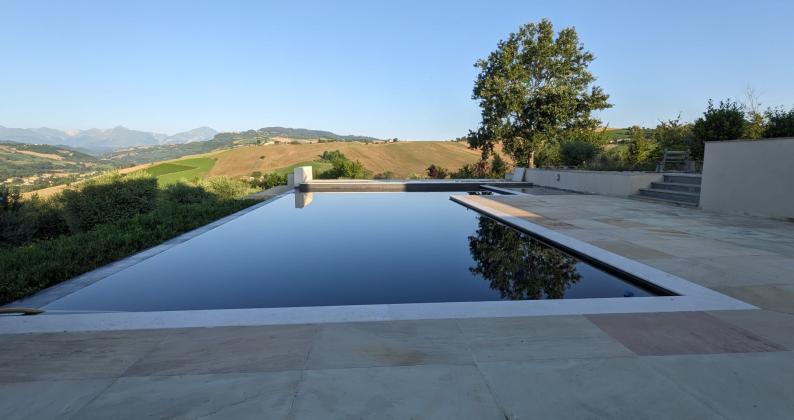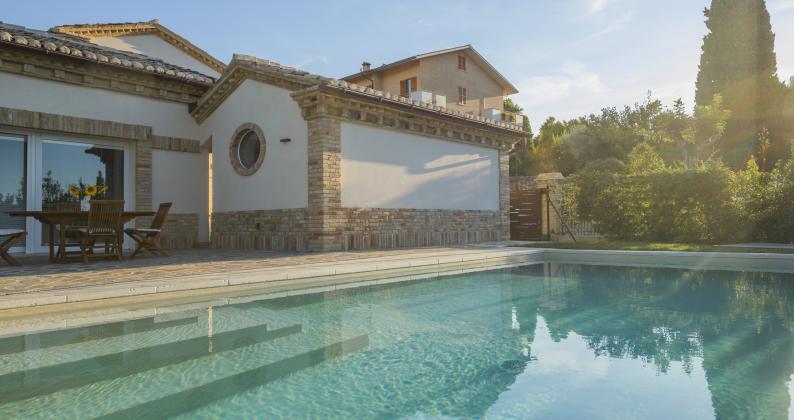Even this topic is part of the common questions of our public: for the pool, better salt or chlorine sterilization?
In this article I will do a simple and concise treatment. We will then be able to deepen the subject during our meeting here in the company.
POOL STERILIZATION SYSTEMS
First of all we must say that the water in the pool is cleaned in two ways:
1) by mechanical cleaning
2) by chemical sterilization
Both are necessary and one does NOT replace the other.
Mechanical cleaning is performed through the filter that retains impurities of a physical nature such as insects, small debris, leaves, hair, etc. Inside the filter you can put various materials such as sand, quartzite, glass or polyester fiber. Sand is the most used element, even if not the best; in fact it has a value of debris / dirt present in water of 40/60 microns against 5/10 microns of the other systems (the micron is one thousandth of a millimeter).
The chemical cleaning takes place through the sterilization of water through the use of chemicals that are used to kill bacteria in the tank. This is done using two main factors: pH regulation and disinfectant regulation (such as chlorine).
The PH of water is the fundamental element to be checked because if it does not remain in the allowed and suitable values (ie between 72 and 76) the chlorine (or whoever it is) does not work.
The insertion of the products that regulate these two functions, takes place manually or automatically.
The manual one is done by checking the values through a test tube that is immersed for a few seconds in the pool water, which can provide the data necessary to understand if and when it is necessary to tuck up the sterilization products.
The automatic one is carried out by a control unit that takes care of two things autonomously:
- Read the values of PH and chlorine
- Automatically dosing the necessary chemicals according to the readings taken
Given this, we can come to the point!
MANUAL OR AUTOMATIC STERILIZATION?
In addition to the fact that you do not have to introduce the product manually into the pool (and it's no small thing!), The automated control unit offers the great advantage of maintaining a constant level of sterilization of the water while manual disinfection has the characteristic of having peaks and lack of more pronounced chlorine.
Being able to choose, I would therefore advise my clients to opt for the automated system for water sterilization.
LIQUID CHLORINE UNIT
There are different types of automatic control units of which the simplest is precisely that PH / CHLORINE that reads the value of both and, after taking the product from special containers, it enters directly into the pool.
SALT UNIT
In this case, once a year the salt is introduced into the pool pool and then, when the water passes through the control unit, an electrolytic process is generated, thanks to which the salt is broken down into various compounds, including hypochlorite (which in fact it is the same chlorine-sterilizing agent) that is then introduced into the water by sterilizing it.
WHAT ARE THE DIFFERENCES BETWEEN THE SALT AND THE CHLORINE UNIT?
- In chlorine sterilization we have two tanks connected to the control unit: one for the PH and one for the chlorine. In salt sterilization, on the other hand, there is only one tank connected to the control unit, ie that of the PH.
- With salt sterilization the perception of the taste of the water is slightly salty and therefore usually more pleasant (3/4 grams per liter versus 30 grams of sea water).
- With chlorine sterilization (in tablets or in powder) you have an accumulation of cyanuric acid, while with that in salt no. Cyanuric acid is a substance that can be quite irritating but necessary so that the action of the sun does not cancel the effect of chlorine in water. This substance is present in small quantities in the chlorine tablets which are placed in the pool, but over time it is accumulated as not all the cyanuric acid of each tablet is necessary for the sun protection function. However, this accumulation does not occur with the chlorine produced by salt sterilization. A certain amount increases the effect of chlorine while in high quantities it even inhibits sterilization.
- The sterilization of the salt guarantees the quality of the sterilizing agent as it is produced directly from the salt, while in the liquid chlorine, in powder or in tablets, there is no certainty of the purity of the components. With chlorine sterilization you risk therefore entering garbage and junk in the pool as many products are sourced 'unreliable' and may be mixed with non-recommendable substances (that's why we at Pool Profession have high quality products that cost more but that are of provenance and certain composition!).
- For those who use liquid chlorine, this can lose its effectiveness over time (whether open or not) and therefore can make water sterilization less effective (the phenomenon is called "losing the title").
MAGNESIUM AND COPPER STERILIZATION
- A further disinfection system is copper sterilization, the UNICO which allows an effective sterilization with the total absence of chlorine. Precisely for this reason the cost of this sterilization system is however higher than the others.
- There is also the magnesium sterilization system, which you can learn more by reading our article.
- A further sterilization system is that of UV rays. This is a device capable of sterilizing the water once it has come out of the filter. This equipment works very well in reality, but has a limit: near the corners of the pool, the skimmer frames
and those of the nozzles, the bacteria continue to proliferate. For this it is however necessary to introduce a certain amount of chlorine in the pool, a quantity that will be logically much lower than those of classical chlorine sterilization.
PLEASE NOTE: you must in any case know that, regardless of any type of control unit you choose, at the beginning of the season - during the season - and - at the end of it, the so-called 'chlorine shock treatments' must be carried out.
PRICES OF VARIOUS TYPES OF POOL UNITS
Here is an estimate of prices for the main types of control unit for the sterilization of pool water:
- CHLORINE UNIT = 2.300 / 2.700 + IVA
- SALT UNIT = 3.000 / 4.500 + IVA (those of latest generation = 5.000 / 8.000)
- COPPER UNIT = 5.500 / 7.000 + IVA
- UV SYSTEM = 1.400 / 2.500 + IVA
- MAGNESIUM UNIT = 30% or 50% more than the salt one (depending on the pool dimensions)
If you want to deepen the subject and be guided in the best system for the sterilization of your pool, contact me for an appointment. I will answer any further questions you want to ask me.
I also remind you that the pool sterilization system can also be changed on existing pools.
So I'll wait for you!
And remember ... may the force be with you!


